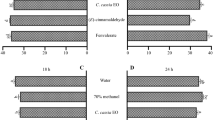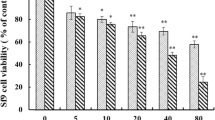Abstract
Neonicotinoids have high agonistic affinity to insect nicotinic acetylcholine receptors (nAChR) and are frequently used as insecticides against most devastating lepidopteran insect pests. Imidacloprid influenced dose-dependent decline in the state III and IV respiration, respiration control index (RCI), and P/O ratios, in vitro and in vivo. The bioassay indicated its LD50 value to be 531.24 μM. The insecticide exhibited a dose-dependent inhibition on F0F1-ATPase and complex IV activity. At 600 μM, the insecticide inhibited 83.62 and 27.13% of F0F1-ATPase and complex IV activity, respectively, and induced the release of 0.26 nmoles/min/mg protein of cytochrome c. A significant dose- and time-dependent increase in oxidative stress was observed; at 600 μM, the insecticide correspondingly induced lipid peroxidation, LDH activity, and accumulation of H2O2 content by 83.33, 31.51 and 223.66%. The stress was the maximum at 48 h of insecticide treatment (91.58, 35.28, and 189.80%, respectively). In contrast, catalase and superoxide dismutase were reduced in a dose- and time-dependent manner in imidacloprid-fed larvae. The results therefore suggest that imidacloprid impedes mitochondrial function and induces oxidative stress in H. armigera, which contributes to reduced growth of the larvae along with its neurotoxic effect.









Similar content being viewed by others
References
Ahmad S, Ansari MS, Ahmad N (2013) Acute toxicity and sublethal effects of the neonicotinoid imidacloprid on the fitness of Helicoverpa armigera (Lepidoptera: Noctuidae). Int J Trop Insect Sci 33:264–275
Akbar SMD, Sharma HC, Jayalakshmi SK, Sreeramulu K (2012a) Methylparathion- and carbofuran-induced mitochondrial dysfunction and oxidative stress in Helicoverpa armigera(Noctuidae: lepidoptera). Pestic Biochem Physiol 103:31–37
Akbar SMD, Sharma HC, Jayalakshmi SK, Sreeramulu K (2012b) Interaction of plant cell signaling molecules, salicylic acid and jasmonic acid, with the mitochondria of Helicoverpa armigera. J Bioenerg Biomembr 44:233–241
Akbar SM, Aurade RM, Sharma HC, Sreeramulu K (2014) Mitochondrial P-glycoprotein ATPAse contributes to insecticide resistance in the cotton bollworm, Helicoverpa armigera (Noctuidae: Lepidoptera). Cell Biochem Biophys 70:651–660
Ameta OP, Bunkner GK (2007) Efficacy of flubendiamide against fruit borer, Helicoverpa armigera in tomato with safety to natural enemies. Indian J Plant Prot 35:235–237
Baginski ES, Foa PP, Zak B (1967) Determination of phosphate: study of labileorganic phosphate interference. Clin Chim Acta 15:155–161
Bai D, Lummis S, Leicht W, Breer H, Sattelle D (1991) Actions of imidacloprid and a related nitromethylene on cholinergic receptors of an identified insect motor neurone. Pestic Sci 33:197–204
Bianchi CM, Genova L, Castelli GP, Lenaz G (2004) The mitochondrial respiratory chain is partially organized in a supercomplex assembly. Kinetic evidence using flux control analysis. J Biol Chem 279:36562–36569
Campbell JB, Nath R, Gadau J, Fox T, DeGradi-Hoffman G, Harrison JF (2016) The fungicide pristine® inhibits mitochondrial function in vitro but not flight metabolic rates in honeybees. J Insect Physiol 86:11–16
Carneiro E, Silva LB, Maggioni K, dos Santos VB, Rodrigues TF, Reis SS, Pavan BE (2014) Evaluation of insecticides targeting control of Helicoverpa armigera (Hubner) (Lepidoptera: Noctudae). American J Plant Sci 5:2823–2828
Chakraborty H, Chakraborty PK, Raha S, Mandal PC, Sarkar M (2007) Interaction of piroxicam with mitochondrial membrane and cytochrome c. Biochim Biophys Acta 1768:1138–1146
Chamberlin ME (2007) Changes in mitochondrial electron transport chain activity during insect metamorphosis. Am J Physiol Regul Integr Comp Physiol 292:1016–1022
Chance B, Seis H, Boveris A (1979) Hydroperoxide metabolism in mammalian organs. Physiol Rev 59:527–605
Crabtree B, Newsholme EA (1972) The activities of phosphorylase, hexokinase, phosphofructokinase, lactate dehydrogenase and the glycerol 3-phosphate dehydrogenases in muscles from vertebrates and invertebrates. Biochem J 126:49–58
Davey GP, Clark JB (1996) Threshold effects and control of oxidative phosphorylation in nonsynaptic rat brain mitochondria. J Neurochem 66:1617–1624
Desagher S, Osen-Sand A, Nichols A, Eskes R, Montessuit S, Lauper S, Maundrell K, Antonsson B, Jean-Claude M (1999) Bid-induced conformational change of Bax is responsible for mitochondrial cytochrome c release during apoptosis. J Cell Biol 144:891–901
Dikshit AK, Lal OP (2002) Safety evaluation and persistence of imidacloprid on acid lime (Citrus aurantiifolia Swingle). Bull Environ Contam Toxicol 68:495–501
Dua R, Gill KD (2001) Aluminium phosphide exposure: implications on rat brain lipid peroxidation and antioxidant defence system. Pharmacol Toxicol 89:315–319
Gassner B, Wüthrich A, Schooltysik G, Solioz M (1997) The pyrethroids permethrin and cyhalothrin are potent inhibitors of mitochondrial complex I. J Pharmacol Exp Therapeut 281:855–860
Gupta S, Gajbhiye VT, Kalpana ANP (2002) Leaching behavior of imidacloprid formulations in soil. Bull Environ Contam Toxicol 68:502–508
Han Y, Wu S, Li Y, Jian-Wei L, Campbell PM, Farnsworth C, Scott C, Russell RJ, Oakeshott JG, Wu Y (2012) Proteomic and molecular analyses of esterases associated with monocrotophos resistant in Helicoverpa armigera. Pestic Biochem Physiol 104:243–251
Janqueira VBC, Simizu K, Videla LA, Barros SBDM (1986) Dose-dependent study of the effect of acute lindane administration on rat liver superoxide anion production, antioxidant enzyme activities and lipid peroxidation. Toxicology 41:193–204
Johnson KM, Cleary J, Fierke CA, Opipari AW, Glick GD (2006) Mechanistic basis for therapeutic targeting of the mitochondrial F1F0-ATPase. ACS Chem Biol 5:304–308
Jovanović P, Žorić L, Stefanović I, Džunić B, Djordjević-Jocić J, Radenković M, Jovanović M (2010) Lactate dehydrogenase and oxidative stress activity in primary open-angle glaucoma aqueous humour. Bosn J Basic Med Sci 10(1):83–88
Kamboj SS, Kumar V, Kamboj A, Sandhir R (2008) Mitochondrial oxidative stress and dysfunction in rat brain induced by carbofuran exposure. Cell Mol Neurobiol 28:961–969
Korshunov SS, Krasnikov BF, Pereverzev MO, Skulachev VP (1999) The antioxidant functions of cytochrome c. FEBS Lett 462:192–198
Kumar S, Park J, Kim E, Na J, Chun YS, Kwon H, Kim W, Kim Y (2015) Oxidative stress induced by chlorine dioxide as an insecticidal factor to the Indian meal moth, Plodia interpunctella. Pestic Biochem Physiol 124:48–59
Li P, Nijhawan D, Budihardjo I, Srinivasula SM, Ahmad M, Alnemri ES, Wang X (1997) Cytochrome c and dATP-dependent formation of apaf-1/caspase-9 complex initiates an apoptotic protease cascade. Cell 91:479–489
Liu MY, Casida JE (1993) High affinity binding of [3H]imidacloprid in the insect acetylcholine receptor. Pestic Biochem Physiol 46:40–46
Lowry OH, Rosebrough NJ, Farr AL, Randall RJ (1951) Protein measurements with the folin phenol reagent. J Biol Chem 193:265–275
Martinez-Cruz O, Sanchez-Paz A, Garcia-Carreño F, Jimenez-Gutierrez L, del Toro M. de los AN, Muhlia-Almazan A (2012) Invertebrates mitochondrial function and energetic challenges. Bioenergetics, ISBN 978-953-51-0090-4, Edited by: Kevin Clark Publisher: InTech, pp 181–218
Mehta A, Verma RS, Srivastava N (2009) Chloropyrifos induced alterations in the levels of hydrogen peroxide, nitrate and nitrite in rat brain and liver. Pestic Biochem Physiol 94:55–59
Nicodemo D, Maioli MA, Medeiros HCD, Guelfi M, Balieira KVB, De Jong D, Mingatto FE (2014) Fipronil and imidacloprid reduce honeybee mitochondrial activity. Environ Toxicol Chem 33:2070–2075
Nooren Z, Ashraf M (2009) Changes in antioxidant enzymes and some key metabolites in some genetically diverse cultivars of radish (Raphanussativus L.) Environ Exp Bot 67:395–402
Olgun S, Misra HP (2006) Pesticides induced oxidative stress in thymocytes. Mol Cell Biochem 290:137–144
Overmyer JP, Mason BN, Armbrust KL (2005) Acute toxicity of imidacloprid and fipronil to a nontarget aquatic insect, Simulium vittatum zetterstedt cytospecies IS-7. Bull Environ Contam Toxicol 74:872–879
Paradies G, Petrosillo G, Pistoles P, Ruggiero FM (2001) Reactive oxygen species generated by mitochondrial respiratory chain affect the complex III activity via cardiolipin peroxidation in beef-heart submitochondrial particles. Mitochondrion 1:151–159
Petrosillo G, De Benedictis V, Ruggiero FM, Paradies G (2013) Decline in cytochrome c oxidase activity in rat-brain mitochondria with aging. Role of peroxidized cardiolipin and beneficial effect of melatonin. J Bioenerg Biomembr 45:431–440
Regupathy A, Ramasubramanian T, Ayyasamy R (2004) Rationale behind the use of insecticide mixtures for the management of insecticide resistance in India. J Food Agric Environ 2:278–284
Shang JY, Shao YM, Lang GJ, Yuan G, Tang ZH, Zhang CX (2007) Expression of two types of acetylcholinesterase gene from the silkworm, Bombyx mori, in insect cells. Insect Sci 14:443–449
Sharma HC (2005) Heliothis/Helicoverpamanagement—emerging trends and strategies for future research, Oxford and IBH Publishing Co, New Delhi
Stoughton SJ, Liber K, Culp J, Cessna A (2008) Acute and chronic toxicity of imidacloprid to the aquatic invertebrates Chironomus tentans and Hyalella azteca under constant- and pulse-exposure conditions. Arch Environ Contam Toxicol 54:662–673
Suchail S, Guez D, Belzunces L (2000) Characteristics of imidacloprid toxicity in two Apis mellifera subspecies. Environ Toxicol Chem 19:1901–1905
Tomizawa M, Casida JE (2005) Neonicotinoid insecticide toxicology: mechanisms of selective action. Annu Rev Pharmacol Toxicol 45:247–268
Yogeeswarudu B, Venkata Krishna K (2014) Field studies on efficacy of novel insecticides against Helicoverpa armigera (Hubner) infesting on chickpea. J Entomol Zool Stud 2:286–289
Zhang A, Kayser H, Maienfisch P, Casida JE (2000) Insect nicotinic acetylcholine receptor: conserved neonicotinoid specificity of [3H]imidacloprid binding site. J Neurochem 75:1294–1303
Zhou JY, Prognon P (2006) Raw material enzymatic activity determination: a specific case for validation and comparison of analytical methods. The example of superoxide dismutase (SOD). J Pharm Biomed Anal 40:1143–1148
Zhu YC, Adamczyk J, Rinderer T, Yao J, Danka R, Luttrell R, Gore J (2015) Spray toxicity and risk potential of 42 commonly used formulations of row crop pesticides to adult honey bees (Hymenoptera: Apidae). J Econ Entomol 108:2640–2647
Zhu YC, Yao J, Adamczyk J, Luttrell R (2017) Synergistic toxicity and physiological impact of imidacloprid alone and binary mixtures with seven representative pesticides on honey bee (Apis mellifera). PLoS One 12(5):1–16. https://doi.org/10.1371/journal.pone.0176837
Acknowledgements
The present work was carried out at the Insect Rearing Laboratory, Entomology, ICRISAT, Hyderabad. It was supported by Gulbarga University, Gulbarga, India, under financial assistance for Ph.D. students (No. GUG/SC/ST cell/2013-14/375) and Special Assistance Programme (SAP) sanctioned to the Department by Govt. of India.
Author information
Authors and Affiliations
Corresponding author
Rights and permissions
About this article
Cite this article
Nareshkumar, B., Akbar, S.M., Sharma, H.C. et al. Imidacloprid impedes mitochondrial function and induces oxidative stress in cotton bollworm, Helicoverpa armigera larvae (Hubner: Noctuidae). J Bioenerg Biomembr 50, 21–32 (2018). https://doi.org/10.1007/s10863-017-9739-3
Received:
Accepted:
Published:
Issue Date:
DOI: https://doi.org/10.1007/s10863-017-9739-3




